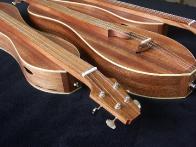
I was able to scrounge enough old parts and pieces together to get my first impressions of the 3D printed dulcimer. Put aside all you thought you knew about what makes a great sounding dulcimer, because this thing sounds amazing. If blindfolded, I doubt that I could tell the difference between it and my latest all wood instruments. It has all the volume, tone, sustain, sensitivity and balance your could ask for. And it's just a pile of cast off parts in a printed body. The soundboard is an early yellow cedar top from an obsolete nylon string design with fan bracing. Considering what the newer X braced and parallel braced tops added to the standard wood instruments, I expect even more from it in the future. In the photo the top is clamped to the body so that it can be removed, so the frames and bolts are not part of the final dulcimer.
I even printed a bridge yesterday to see how it would work. It's working so well I may never get around to trying a wood bridge.

So I think I have confirmed several things:
-
The body has little effect on the sound relative to the overall design and the soundboard used.
-
The advantages of having the entire top free to vibrate are a constant that is independent of the body material.
-
The double bottom approach works just as well in a printed body as in a wood instrument. This is interesting because apparently the inner back material is not all that important. The printed body has the inner back and its ribs printed right into it- so it's all one piece of plastic.
-
There is a significant advantage to having the strings terminate at the tailpiece that is not diminished by altering the body material or the bracing scheme. My last three designs have all used this method and the results have been positive with fan, X and parallel bracing. I doubt that I will return to strings that terminate at the bridge. I am struggling to understand exactly why this works so well. Intuitively, the low string break angle would seem to impart less exciting force to the soundboard than to the combined torque and tension that terminating the strings at the bridge causes. And yet, even with a relatively stiff fan braced soundboard designed to sustain the loading for strings attached to the bridge, the dulcimer is louder when the strings run over the bridge to the tail.
Considering that this experiment was a rather crude attempt and that there are many more materials and design options to pursue, I am convinced that there is a future for 3D printing in lutherie. It provides an option to rapidly test new ideas and has the possibility of lowering the cost of limited production designs. With the cost of large format printers continuing to fall and new materials coming onto the market daily, the technology will have ever increasing potential to bring us new and exciting instruments.

